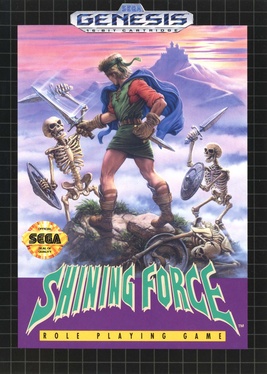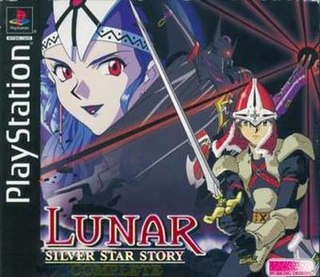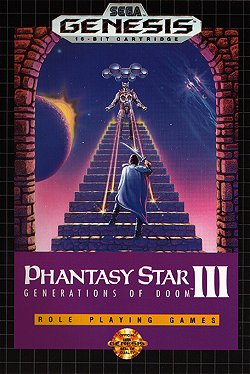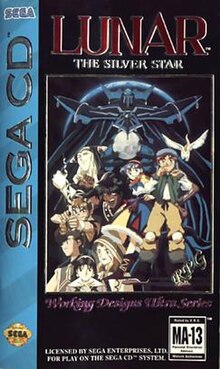
The Sega CD, known as Mega-CD in most regions outside North America and Brazil, is a CD-ROM accessory for the Sega Genesis produced by Sega as part of the fourth generation of video game consoles. It was released on December 12, 1991, in Japan, October 15, 1992, in North America, and April 2, 1993, in Europe. The Sega CD plays CD games and adds hardware functionality such as a faster CPU and graphic enhancements such as sprite scaling and rotation. It can also play audio CDs and CD+G discs.

Phantasy Star is a role-playing video game (RPG) developed by Sega and released for the Master System in 1987. One of the earliest Japanese RPGs for consoles, Phantasy Star tells the story of Alis on her journey to defeat the evil ruler of her star system, King Lassic, after her brother dies at his hands. She traverses between planets, gathering a party of fighters and collecting the items she needs to avenge her brother's death and return peace to the star system. The gameplay features traditional Japanese RPG elements including random encounters and experience points. All the characters have predefined personalities and abilities, a unique element compared to the customizable characters of other RPGs of the era.

Phantasy Star II is a science fantasy role-playing video game developed and published by Sega for the Sega Genesis. It was released in Japan in 1989, North America in 1990, and in Europe in 1990. It was later ported to a variety of different platforms. An updated remake, Phantasy Star Generation 2, was released for the PlayStation 2 in 2005 in Japan.

Lunar is a series of role-playing video games, developed by Game Arts in Japan and published in the United States by Working Designs, Ubisoft, and Xseed Games.

Shining Force is a 1992 turn-based tactical role-playing game for the Sega Genesis console. It is the second entry of the Shining series of video games, following Shining in the Darkness. While primarily a traditional fantasy-themed game, it contains some science fiction elements.
The Shining series is a brand of role-playing video games published by Sega, who owns the property. The first game, Shining in the Darkness, was a first-person dungeon crawler with randomly encountered, turn-based battles. The next game released in the series was Shining Force, which was a turn-based strategy style tactical role-playing game with battle scenes acted out with sprites. Other directions include Shining Soul, a dungeon crawl action role-playing game with roguelike elements, and a number of traditional Japanese role-playing games. Shining Resonance Refrain was released on PlayStation 4, Xbox One, Steam PC and Nintendo Switch worldwide across 2018.

Lunar: Silver Star Story Complete, originally released in Japan as simply Lunar: Silver Star Story, is a role-playing video game developed by Game Arts and Japan Art Media as a remake of 1992's Lunar: The Silver Star. While the overall plot remains true to the original, accommodations are made to the game's story to allow for a larger, richer cast, as well as additional scenarios.

Shining in the Darkness, released as Shining and the Darkness in Japan, is a 1991 role-playing video game for the Mega Drive/Genesis video game console. It was one of the first role-playing games released for the system, and was the first in the Shining series.

Phantasy Star III: Generations of Doom is a role-playing video game developed and published by Sega. It was released for the Sega Genesis in Japan in April 1990 and worldwide the following year. It is the third game in the original Phantasy Star series, and is a distant sequel to the previous games. However, gameplay is similar to the previous games, with turn-based combat and random encounters. Players explore various overworld maps and dungeons in order to progress through the game. It was later re-released on the Virtual Console and on retro collections such as the Phantasy Star Collection, Sega Genesis Collection, and Sonic's Ultimate Genesis Collection.

Working Designs was an American video game publisher that specialized in the localization of Japanese role-playing video games, strategy video games and top-down shooters for various platforms. Though the company had published many cult hits, it was known best to fans as the long-time exclusive North American publisher of the Lunar series. The company was one of the few game publishers that attempted to bridge the cultural gap between the Japanese and American video game industries during the 1990s with an eclectic selection of releases from various genres, and was also one of the earliest American publishers to make use of the CD-ROM format for full, spoken English dialogue in their titles at a time when voice acting was not a common feature in most mainstream games.

Albert Odyssey: Legend of Eldean is a role-playing video game produced by Sunsoft for the Sega Saturn. It was originally made for the Super NES, and ported to the Saturn late in its development. Released in Japan in August 1996, the game was made available in North America in July 1997 by Working Designs.

Shining Force II is a tactical role-playing game for the Mega Drive/Genesis console developed by Sonic! Software Planning and published by Sega in 1993. Its storyline is not directly connected to the original Shining Force, although a Game Gear title Shining Force Gaiden: Final Conflict links the two games' plots.
Phantasy Star is a series of console role-playing video games and other supplementary media created by Sega. The series debuted in 1987 on the Master System with Phantasy Star, and continues into the present with Phantasy Star Online 2 and other extensions of the Phantasy Star Online sub-series. Each of the games in the series features a science fantasy setting featuring a cross-genre combination of magic and technology.

Lunar Legend is a role-playing video game for Nintendo's Game Boy Advance developed by Japan Art Media and published internationally by Ubi Soft, who also provided the translation. It is a re-telling of the events of Lunar: The Silver Star with story and content changes. All the characters from the original game appear.

Lunar: Eternal Blue is a role-playing video game developed by Game Arts in association with Studio Alex for the Sega CD as the sequel to Lunar: The Silver Star. The game was originally released in December 1994 in Japan, and later in North America in September 1995 by Working Designs. Eternal Blue expanded the story and gameplay of its predecessor, and made more use of the Sega CD's hardware, including more detailed graphics, longer, more elaborate animated cutscenes, and more extensive use of voice acting. Critics were mostly pleased with the title, giving particular merit to the game's English translation and further expansion of the role-playing game genre in CD format.

Popful Mail: Magical Fantasy Adventure is a side-scrolling platform game developed by Nihon Falcom. It was originally released for the NEC PC-8801 home computer in 1991 and the PC-9801 in 1992. The game was later ported to the PC Engine CD-ROM by NEC Home Electronics, to the Sega CD by Sega, to DoJa mobile phones by Bothtec, and to the Super Famicom and Microsoft Windows by Falcom.

Rieko Kodama, also known as Phoenix Rie, was a Japanese video game artist, director, and producer employed by Sega from 1984 until her death. She is primarily known for her work on role-playing video games including the original Phantasy Star series, the 7th Dragon series, and Skies of Arcadia (2000). She is often recognized as one of the first successful women in the video game industry.

Panzer Dragoon is a series of video games developed by Sega. The first three games—Panzer Dragoon (1995), Panzer Dragoon II Zwei (1996), and Panzer Dragoon Saga (1998)—were produced by Sega's Team Andromeda for the Sega Saturn. The fourth, Panzer Dragoon Orta (2002), was developed by Sega's Smilebit team for the Xbox. Spin-offs include Panzer Dragoon Mini (1996) for the handheld Game Gear in Japan. A remake of Panzer Dragoon was released in 2020.

Lunar: Silver Star Harmony, known in Japan as Lunar: Harmony of Silver Star, is the third remake of the 1992 role-playing video game Lunar: The Silver Star. It was developed by Game Arts in 2009 and released exclusively for the PlayStation Portable by GungHo Works in Japan, by Xseed Games North America, and by Game Arts in Europe and Australia.


















